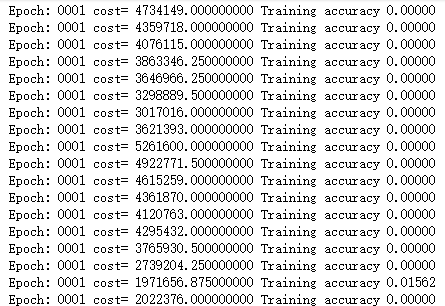吴裕雄 python神经网络 水果图片识别(2)
import os
import numpy as np
import matplotlib.pyplot as plt
from skimage import color,data,transform,io
labelList = os.listdir("F:\\MachineLearn\\ML-xiaoxueqi\\fruits\\Training")
allFruitsImageName = []
for i in range(10):
allFruitsImageName.append(os.listdir("F:\\MachineLearn\\ML-xiaoxueqi\\fruits\\Training\\"+labelList[i]))
allsortImageName = []
for i in range(len(allFruitsImageName)):
oneClass = allFruitsImageName[i]
nr = []
r = []
r2 = []
for i in range(len(oneClass)):
if(oneClass[i].split("_")[0].isdigit()):
nr.append(int(oneClass[i].split("_")[0]))
else:
if(len(oneClass[i].split("_")[0])==1):
r.append(int(oneClass[i].split("_")[1]))
else:
r2.append(int(oneClass[i].split("_")[1]))
sortnr = sorted(nr)
sortnrImageName = []
for i in range(len(sortnr)):
sortnrImageName.append(str(sortnr[i])+"_100.jpg")
sortr = sorted(r)
sortrImageName = []
for i in range(len(sortr)):
sortrImageName.append("r_"+str(sortr[i])+"_100.jpg")
sortr2 = sorted(r2)
sortr2ImageName = []
for i in range(len(sortr2)):
sortr2ImageName.append("r2_"+str(sortr2[i])+"_100.jpg")
sortnrImageName.extend(sortrImageName)
sortnrImageName.extend(sortr2ImageName)
allsortImageName.append(sortnrImageName)
trainData = []
trainLabel = []
for i in range(len(allsortImageName)):
for j in range(len(allsortImageName[i])):
trainLabel.append(i)
rgb=io.imread("F:\\MachineLearn\\ML-xiaoxueqi\\fruits\\Training\\"+labelList[i]+"\\" + allsortImageName[i][j]) #读取图片
# gray=color.rgb2gray(rgb) #将彩色图片转换为灰度图片
dst=transform.resize(rgb,(32,32)) #调整大小,图像分辨率为64*64
trainData.append(dst)
import tensorflow as tf
from random import shuffle
import keras
import time
from keras.utils import np_utils
X = np.vstack(trainData).reshape(-1, 32,32,3)
Y = np.vstack(trainLabel).reshape(-1, 1)
Xrandom = []
Yrandom = []
index = [i for i in range(len(X))]
shuffle(index)
train_x=X[index]
train_y=Y[index]
train_y=keras.utils.to_categorical(Y,10)
## 配置神经网络的参数
n_classes=10
batch_size=64
kernel_h=kernel_w=5
dropout=0.8
depth_in=3
depth_out1=64
depth_out2=128
image_size=train_x.shape[1] ##图片尺寸
n_sample=train_x.shape[0] ##样本个数
x=tf.placeholder(tf.float32,[None,32,32,3]) ##每张图片的像素大小为32*32
y=tf.placeholder(tf.float32,[None,n_classes])
keep_prob=tf.placeholder(tf.float32) ##dropout的placeholder(解决过拟合)
fla=int((image_size*image_size/16)*depth_out2)#扁平化用到
##定义权重变量
Weights={"con1_w":tf.Variable(tf.random_normal([kernel_h,kernel_w,depth_in,depth_out1])),\
"con2_w":tf.Variable(tf.random_normal([kernel_h,kernel_w,depth_out1,depth_out2])),\
"fc_w1":tf.Variable(tf.random_normal([int((image_size*image_size/16)*depth_out2),512])),\
"fc_w2":tf.Variable(tf.random_normal([512,128])),\
"out":tf.Variable(tf.random_normal([128,n_classes]))}
##定义偏置变量
bias={"conv1_b":tf.Variable(tf.random_normal([depth_out1])),\
"conv2_b":tf.Variable(tf.random_normal([depth_out2])),\
"fc_b1":tf.Variable(tf.random_normal([512])),\
"fc_b2":tf.Variable(tf.random_normal([128])),\
"out":tf.Variable(tf.random_normal([n_classes]))}
## 定义卷积层的生成函数
def conv2d(x,W,b,stride=1):
x=tf.nn.conv2d(x,W,strides=[1,stride,stride,1],padding="SAME")
x=tf.nn.bias_add(x,b)
return tf.nn.relu(x)
## 定义池化层的生成函数
def maxpool2d(x,stride=2):
return tf.nn.max_pool(x,ksize=[1,stride,stride,1],strides=[1,stride,stride,1],padding="SAME")
## 定义卷积神经网络生成函数
def conv_net(x,weights,biases,dropout):
## Convolutional layer 1(卷积层1)
with tf.name_scope('convLayer1'):
conv1 = conv2d(x,Weights['con1_w'],bias['conv1_b']) ##32*32*64
tf.summary.histogram('convLayer1/weights1',Weights['con1_w'])
tf.summary.histogram('convLayer1/bias1',bias['conv1_b'])
tf.summary.histogram('convLayer1/conv1',conv1)
pool1 = maxpool2d(conv1,2) ##经过池化层1 shape:16*16*64
## Convolutional layer 2(卷积层2)
with tf.name_scope('convLayer2'):
conv2 = conv2d(pool1,Weights['con2_w'],bias['conv2_b']) ##16*16*128
tf.summary.histogram('convLayer2/weights2',Weights['con2_w'])
tf.summary.histogram('convLayer2/bias2',bias['conv2_b'])
tf.summary.histogram('convLayer2/conv2',conv2)
pool2 = maxpool2d(conv2,2) ##经过池化层2 shape:8*8*128
tf.summary.histogram('ConvLayer2/pool2',pool2)
flatten = tf.reshape(pool2,[-1,fla]) ##Flatten层,扁平化处理
fc1 = tf.add(tf.matmul(flatten,Weights['fc_w1']),bias['fc_b1'])
fc1r = tf.nn.relu(fc1) ##经过relu激活函数
## Fully connected layer 2(全连接层2)
fc2 = tf.add(tf.matmul(fc1r,Weights['fc_w2']),bias['fc_b2']) ##计算公式:输出参数=输入参数*权值+偏置
fc2 = tf.nn.relu(fc2) ##经过relu激活函数
## Dropout(Dropout层防止预测数据过拟合)
fc2 = tf.nn.dropout(fc2,dropout)
## Output class prediction
prediction = tf.add(tf.matmul(fc2,Weights['out']),bias['out']) ##输出预测参数
return prediction
## 优化预测准确率 0.005
prediction=conv_net(x,Weights,bias,keep_prob) ##生成卷积神经网络
cross_entropy=tf.reduce_mean(tf.nn.softmax_cross_entropy_with_logits_v2(logits=prediction,labels=y)) ##交叉熵损失函数
optimizer=tf.train.AdamOptimizer(1e-4).minimize(cross_entropy) ##选择优化器以及学习率
merged=tf.summary.merge_all()
## 评估模型
correct_pred=tf.equal(tf.argmax(prediction,1),tf.argmax(y,1))
accuracy=tf.reduce_mean(tf.cast(correct_pred,tf.float32))
## 初始会话并开始训练过程
with tf.Session() as sess:
tf.global_variables_initializer().run()
# writer=tf.summary.FileWriter("./Fruits(0.001)",sess.graph)
for i in range(5):
for j in range(int(n_sample/batch_size)+1):
start = (j*batch_size)
end = start+batch_size
x_=train_x[start:end]
y_=train_y[start:end]
##准备验证数据
if i % 1 == 0:
validate_feed={x:x_,y:y_,keep_prob:0.8}
sess.run(optimizer, feed_dict=validate_feed)
# result=sess.run(merged,feed_dict=validate_feed)
# writer.add_summary(result,i)
loss,acc = sess.run([cross_entropy,accuracy],feed_dict=validate_feed)
print("Epoch:", '%04d' % (i+1),"cost=", "{:.9f}".format(loss),"Training accuracy","{:.5f}".format(acc))
print('Optimization Completed')

####required libraries
import numpy as np
import tensorflow as tf
import matplotlib.pyplot as plt
import time
from tensorflow.examples.tutorials.mnist import input_data
###########extract data from packages
mnist=input_data.read_data_sets("./MNIST_data",one_hot=True)
train_X,train_Y,test_X,test_Y=mnist.train.images, mnist.train.labels, mnist.test.images, mnist.test.labels
######input data
n_classes=10
x=tf.placeholder(tf.float32,[None,28*28])
y=tf.placeholder(tf.float32,[None,n_classes])
keep_prob = tf.placeholder(tf.float32)
epochs=20
learning_rate=0.01
batch_size=200
batch_num=int(mnist.train.num_examples/batch_size)
dropout=0.75
filter_width=5
filter_height=5
depth_in=1
depth_out1=64
depth_out2=128
f_height=28
######ops:Weights and bias
Weights={"wc1":tf.Variable(tf.random_normal([filter_height,filter_width,depth_in,depth_out1])),\
"wc2":tf.Variable(tf.random_normal([filter_height,filter_width,depth_out1,depth_out2])),\
"wd1":tf.Variable(tf.random_normal([int((f_height*f_height/16)*depth_out2),1024])),\
"out":tf.Variable(tf.random_normal([1024,n_classes]))}
bias={"bc1":tf.Variable(tf.random_normal([depth_out1])),\
"bc2":tf.Variable(tf.random_normal([depth_out2])),\
"bd1":tf.Variable(tf.random_normal([1024])),\
"out":tf.Variable(tf.random_normal([n_classes]))}
##############convolution layer and pooling layer
def conv2d(x,W,b,stride=1):
x=tf.nn.conv2d(x,W,strides=[1,stride,stride,1],padding="SAME")
x=tf.nn.bias_add(x,b)
return tf.nn.relu(x)
def maxpool2d(x,stride=2):
return tf.nn.max_pool(x,ksize=[1,stride,stride,1],strides=[1,stride,stride,1],padding="SAME")
####create the feed forward model
def conv_net(x_,W,b,dropout):
x=tf.reshape(x_,[-1,28,28,1])
####convolution layer 1######
conv1=conv2d(x,W["wc1"],b["bc1"])
conv1=maxpool2d(conv1,2)
####convolution layer 2######
conv2=conv2d(conv1,W["wc2"],b["bc2"])
conv2=maxpool2d(conv2,2)
####fully connected layer#####
fc1=tf.reshape(conv2,[-1,W["wd1"].get_shape().as_list()[0]])
fc1=tf.matmul(fc1,W["wd1"])
fc1=tf.add(fc1,b["bd1"])
fc1=tf.nn.relu(fc1)
######Apply dropout####
fc1=tf.nn.dropout(fc1,dropout)
######output layer####
out=tf.matmul(fc1,W["out"])
out=tf.add(out,b["out"])
return out
'''C O N V O L U T I O N L A Y E R'''
def conv2d(x,W,b,strides=1):
x = tf.nn.conv2d(x,W,strides=[1,strides,strides,1],padding='SAME')
x = tf.nn.bias_add(x,b)
return tf.nn.relu(x)
''' P O O L I N G L A Y E R'''
def maxpool2d(x,stride=2):
return tf.nn.max_pool(x,ksize=[1,stride,stride,1],strides=[1,stride,stride,1],padding='SAME')
def conv_net(x,weights,biases,dropout):
x = tf.reshape(x,shape=[-1,28,28,1])
##################################################
## Convolutional layer 1
conv1 = conv2d(x,weights['wc1'],biases['bc1'])
conv1 = maxpool2d(conv1,2)
## Convolutional layer 2
conv2 = conv2d(conv1,weights['wc2'],biases['bc2'])
conv2 = maxpool2d(conv2,2)
## Now comes the fully connected layer
fc1 = tf.reshape(conv2,[-1,weights['wd1'].get_shape().as_list()[0]])
fc1 = tf.add(tf.matmul(fc1,weights['wd1']),biases['bd1'])
fc1 = tf.nn.relu(fc1)
## Apply Dropout
fc1 = tf.nn.dropout(fc1,dropout)
## Output class prediction
out = tf.add(tf.matmul(fc1,weights['out']),biases['out'])
return out
########Define tensorflow ops for different activities#####
pred=conv_net(x,Weights,bias,keep_prob)
cost=tf.reduce_mean(tf.nn.softmax_cross_entropy_with_logits(logits=pred,labels=y))
optimizer=tf.train.AdamOptimizer(0.01).minimize(cost)
####Evaluate model
correct_pred=tf.equal(tf.argmax(pred,1),tf.argmax(y,1))
accuracy=tf.reduce_mean(tf.cast(correct_pred,tf.float32))
init=tf.global_variables_initializer()
####################################################
## Launch the execution Graph
####################################################
start_time = time.time()
with tf.Session() as sess:
sess.run(init)
for i in range(epochs):
for j in range(batch_num):
batch_x,batch_y = mnist.train.next_batch(batch_size)
sess.run(optimizer, feed_dict={x:batch_x,y:batch_y,keep_prob:0.75})
loss,acc = sess.run([cost,accuracy],feed_dict={x:batch_x,y:batch_y,keep_prob: 1.})
if epochs % 1 == 0:
print("Epoch:", '%04d' % (i+1),"cost=", "{:.9f}".format(loss),"Training accuracy","{:.5f}".format(acc))
print('Optimization Completed')
y1 = sess.run(pred,feed_dict={x:mnist.test.images[:256],keep_prob: 1})
test_classes = np.argmax(y1,1)
print('Testing Accuracy:',sess.run(accuracy,feed_dict={x:mnist.test.images[:256],y:mnist.test.labels[:256],keep_prob: 1}))
print('Total processing time:',end_time - start_time)
####required libraries
import numpy as np
import tensorflow as tf
import matplotlib.pyplot as plt
import time
from tensorflow.examples.tutorials.mnist import input_data
###########extract data from packages
mnist=input_data.read_data_sets("./MNIST_data",one_hot=True)
# train_X,train_Y,test_X,test_Y=mnist.train.images,mnist.train.labels,mnist.test.images,mnist.test.labels
吴裕雄 python神经网络 水果图片识别(2)的更多相关文章
- 吴裕雄 python神经网络 水果图片识别(5)
#-*- coding:utf-8 -*-### required libaraiedimport osimport matplotlib.image as imgimport matplotlib. ...
- 吴裕雄 python神经网络 水果图片识别(4)
# coding: utf-8 # In[1]:import osimport numpy as npfrom skimage import color, data, transform, io # ...
- 吴裕雄 python神经网络 水果图片识别(3)
import osimport kerasimport timeimport numpy as npimport tensorflow as tffrom random import shufflef ...
- 吴裕雄 python神经网络 水果图片识别(1)
import osimport numpy as npimport matplotlib.pyplot as pltfrom skimage import color,data,transform,i ...
- 吴裕雄 python神经网络 花朵图片识别(10)
import osimport numpy as npimport matplotlib.pyplot as pltfrom PIL import Image, ImageChopsfrom skim ...
- 吴裕雄 python神经网络 花朵图片识别(9)
import osimport numpy as npimport matplotlib.pyplot as pltfrom PIL import Image, ImageChopsfrom skim ...
- 吴裕雄 python 神经网络——TensorFlow图片预处理调整图片
import numpy as np import tensorflow as tf import matplotlib.pyplot as plt def distort_color(image, ...
- 吴裕雄 python 神经网络——TensorFlow 花瓣识别2
import glob import os.path import numpy as np import tensorflow as tf from tensorflow.python.platfor ...
- 吴裕雄 python 神经网络——TensorFlow图片预处理
import numpy as np import tensorflow as tf import matplotlib.pyplot as plt # 使用'r'会出错,无法解码,只能以2进制形式读 ...
随机推荐
- Servlet和JSP比较
1. 两者哟许多相似之处,都可以生成动态网页 2. JSP的优点是擅长于网页制作,生成动态页面,比较直观. JSP的缺点是不容易跟踪与拍错 3. Servlet是纯Java语言,擅长流程处理和业务逻辑 ...
- vim配置之目录结构
我喜欢作配置分离,这样比较好管理,这里直接贴一下tree的目录结构 xxx@debian:~/vimConfig$ tree . ├── install │ ├── install.sh │ ...
- [转载]Linux下关于system调用
曾经的曾经,被system()函数折磨过,之所以这样,是因为对system()函数了解不够深入.只是简单的知道用这个函数执行一个系统命令,这远远不够,它的返回值.它所执行命令的返回值以及命令执行失败原 ...
- 给easyui datebox扩展一个清空按钮
/** * 给时间框控件扩展一个清除的按钮 */ $.fn.datebox.defaults.cleanText = '清空'; (function ($) { var buttons = $.ext ...
- [转]连连看游戏 C#
源代码下载地址 http://files.cnblogs.com/files/z5337/%E8%BF%9E%E8%BF%9E%E7%9C%8B%E6%B8%B8%E6%88%8F.rar 代码由 & ...
- 转载-MyBatis学习总结
MyBatis学习总结(八)——Mybatis3.x与Spring4.x整合 孤傲苍狼 2015-02-07 00:09 阅读:89825 评论:54 MyBatis学习总结(七)——Myba ...
- ubuntu solute two different terminals cmd
sudo update-alternatives --config x-terminal-emulator select 1. gnome-xterminal
- Fix-Dell iDRAC 7 error: RAC0218: The maximum number of user sessions is reached
Hi Everyone, We came across the following error while performing some preventative maintenance check ...
- 每秒查询率QPS
每秒查询率QPS是对一个特定的查询服务器在规定时间内所处理流量多少的衡量标准,在因特网上,作为域名系统服务器的机器的性能经常用每秒查询率来衡量. 原理:每天80%的访问集中在20%的时间里,这20%时 ...
- [UE4]Pawn和Controller,第一人称和第三人称切换
一. Pawn 可以被控制的Actor,可以被Controller持有控制,并且从Controller中接受输入.例如:玩家.NPC(Not Player Character) 二.Controlle ...
